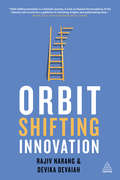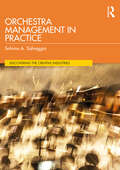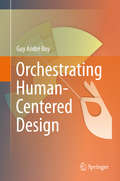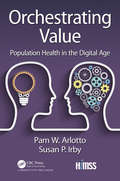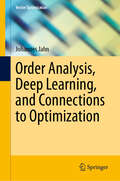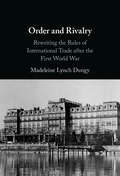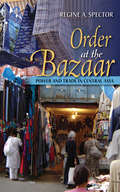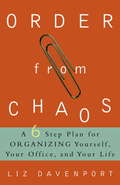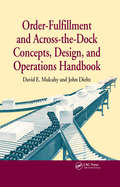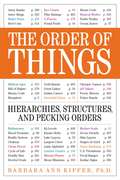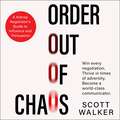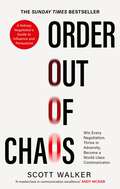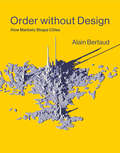- Table View
- List View
Orbit-Shifting Innovation
by Rajiv Narang Devika DevaiahOrbit-shifting innovation happens when an area that needs transformation meets an innovator with the will and the desire to create, and not follow, history. At the heart of every orbit-shifting innovation is the breakthrough that achieves a transformative impact.Businesses, social enterprises and even governments need orbit-shifting ideas to create a transformative impact. But how does that ground breaking idea come about, and what translates it into actuality? Charting the vast global landscape of orbit-shifting innovation and using unique examples from prominent businesses, the social sector, entrepreneurs and public services - spread across US, UK, Europe, Africa and Asia - the authors build insight into the key drivers behind taking on a transformative challenge and provide a unique framework to navigate the pitfalls and challenges in making it happen. Orbit-shifting innovation empowers everyone to overcome the obstacles to innovation and provides the tools to maximize the impact of transformative change. The inspirational examples and tools for success compel leaders and entrepreneurs to not only pursue impossible challenges but lead the successful journey from conception of an orbit-shifting idea to actually creating history.
Orçamentação para Iniciantes: Como Orçamentar
by Adidas WilsonSe a maior parte das pessoas tivessem opção de escolha, prefeririam não ter um orçamento. É limitante e exige muito sacrifício e esforço. Nunca poderá ter falta de desculpas por não ter um orçamento — estar demasiado ocupado, esperar que as coisas mudem brevemente, não ganhar o suficiente, etc. Contudo, um orçamento é poderoso. Vai ajudá-lo a solidificar o seu futuro financeiro, mesmo que não faça muito.
Orchadio's First Two Split Experiments
by David Lane Iavor Bojinov Marco IansitiOrchadio, a direct-to-consumer grocery business, needs to conduct its first two A/B tests-one to evaluate the effectiveness and functioning of its newly redesigned website, and one to market-test four versions of a new banner for the website. To do so, it will rely on a technology management platform designed by Split Software, whose feature flags allow Orchadio engineers to (1) turn specific software features on and off and (2) to limit access to those features to specific groups of website visitors. These capabilities in turn enable A/B feature testing. Split also offers data analytics to allow Orchadio to assess how its tests affect a plethora of Orchadio's business, software, and operating metrics. Orchadio managers now need to decide how to design their experiments for maximum impact, including whether or how to sequence them.
Orchestra Management: Models and Repertoires for the Symphony Orchestra (Routledge Research in the Creative and Cultural Industries)
by Arne HermanEvery orchestra in the world oscillates between crisis and survival. This perpetual movement makes innovation, both in organizational form and in artistic product, vital to the sustainability of the symphony orchestra. Based on case study research in Flanders, Amsterdam and London, this book reflects on the sustainability crisis of the orchestra by framing it as a legitimacy crisis that affects both the orchestra’s artistic and organizational identity. The aim of this book is to explore the dynamics between various and often conflicting factors in the orchestra’s quest for survival, and to show how these organizational dynamics relate to the orchestra’s repertoire. By highlighting the importance of every organization’s specific environment to which it needs to adapt, this book illustrates that the orchestra field is not a field that relies on best practices. The book reflects on conventional as well as innovative orchestra models, making the comparative point of view relevant for academic or practice-based researchers, orchestra managers, policymakers and subsidizing bodies interested in sustainable and future-oriented orchestra management.
Orchestra Management in Practice (Discovering the Creative Industries)
by Salvino A. SalvaggioIntroducing the business models, organisational structures, and fundamentals of orchestras, this book takes readers on a journey through the evolution of orchestra management. The author explores the dynamics between artistic excellence and financial sustainability. Key aspects of orchestra management are examined in detail, including artistic programming, strategic planning, financial and compliance/legal matters, audience development, resilience and adaptability, governance and board relations, diversity and inclusion, partnerships, and the role of technology and innovation. With actionable resources, such as checklists, templates, and frameworks, for current and future orchestra leaders and managers, this comprehensive guide empowers readers in education and practice to navigate the complexities of orchestra management confidently and effectively.
Orchestrate Conflict: Leading Adaptive Change by Surfacing and Managing Conflict
by Alexander Grashow Marty Linsky Ronald HeifetzEveryone has a different capacity for tolerating conflict. Some people are comfortable working through conflict, while most avoid it entirely. But surfacing the relevant conflicts is essential if you want to generate progress on adaptive issues. To do this well requires an approach to conflict that teases out the unacknowledged differences in perspectives on the issues that may be preventing the organization from reaching its goals. It requires acknowledging the many competing visions, values, and views that may be present in the organization even if they are not articulated. Orchestrating conflict isn't easy, but this chapter provides seven steps to follow, along with practices that will help you surmount the difficulties of orchestrating conflict and boost your chances of success. This chapter was originally published as chapter 11 of "The Practice of Adaptive Leadership: Tools and Tactics for Changing Your Organization and the World."
Orchestrate the Conflict (How to Creatively Engage Conflict to Achieve Leadership Goals)
by Ronald A. Heifetz Marty LinskyThis chapter notes that addressing tough issues involves managing conflict. Most people's default mind-set is to limit or deflect conflict. But the challenge of leadership when trying to generate adaptive change is to work with differences, passions, and conflicts in a way that diminishes their destructive potential and constructively harnesses their energy. This chapter was originally published as Chapter 5 of "Leadership on the Line."
Orchestrating Adjacency Moves: Strengthening the Core Versus Investing in Adjacencies
by Chris ZookEven the most attractive growth opportunity can turn unattractive, unrealistic, or even destructive when bolted onto the wrong core business, or onto the right business at the wrong time. Building growth on a core business that is prepared to support it, and for which the new adjacency moves might even reinforce the strength of that core rather than draining it of its energy, is crucial. This chapter examines the issue of timing and assessing the state of the core to support growth.
Orchestrating Human-Centered Design
by Guy BoyThe time has come to move into a more humanistic approach of technology and to understand where our world is moving to in the early twenty-first century. The design and development of our future products needs to be orchestrated, whether they be conceptual, technical or organizational. Orchestrating Human-Centered Design presents an Orchestra model that attempts to articulate technology, organizations and people. Human-centered design (HCD) should not be limited to local/short-term/linear engineering, but actively focus on global/long-term/non-linear design, and constantly identify emergent properties from the use of artifacts. Orchestrating Human-Centered Design results from incremental syntheses of courses the author has given at the Florida Institute of Technology in the HCD PhD program. It is focused on technological and philosophical concepts that high-level managers, technicians and all those interested in the design of artifacts should consider. Our growing software -intensive world imposes better knowledge on cognitive engineering, life-critical systems, complexity analysis, organizational design and management, modeling and simulation, and advanced interaction media, and this well-constructed and informative book provides a road map for this.
Orchestrating Value: Population Health in the Digital Age (HIMSS Book Series)
by Pam Arlotto Susan IrbyOrchestrating Value: Population Health in the Digital Age focuses on the leadership thinking and mindset changes needed to transition from brick and mortar healthcare to digital health and connected care. The fourth industrial revolution, with convergent disruptions in biology, business models, computer science, and culture, has the potential to transform the healthcare system like never before. Digital health startups, Big Tech and progressive health systems will change the way health and healthcare are delivered to increasingly digitally savvy consumers. This book challenges readers to rethink the role of data and technology in creating and designing the future. Rather than hooking value-based care and population health management onto traditional healthcare business models, it focuses on the emergence of digital ecosystems. Using the analogy of an orchestra, the book introduces the importance of platforms in the formation of communities and markets with network effects to allow participants to collaborate, create, and innovate. With quotes from healthcare industry leaders and change agents, it helps the strategist understand the three stages of the transition from volume to value. As conductor of the orchestra, the CEO must navigate important leadership pivots to move beyond silo-based thinking. Finally, the Care Management Platform is described as a new operating model for population health in the digital age. As the next generation beyond foundational EHRs, capabilities such as interoperability, analytics, care management and patient/consumer engagement will fundamentally change the way healthcare enterprises operate and deliver value to customers.
Orchestrator: Choosing the Optimal Business Model for Innovation
by Harold L. Sirkin James P. Andrew John ButmanThe choice of business model can have a dramatic effect on a company's ability to successfully achieve payback with a new product or service. This chapter examines the popular model of innovation collaboration or orchestration, in which risk and payback are shared among partners.
Orchid Partners: A Venture Capital Start-Up
by Myra M. Hart Kristin J. LiebThe development of a new venture partnership and the challenges associated with raising its first fund are chronicled. The decision to focus on early-stage investments, the determination of the appropriate size of the fund, the fund-raising process, and the steps in closing are all examined. Also presents information on the relationships among the five partners, the division of responsibilities, and the compensation package. Provides personal background on each of the partners and explores their motivation for choosing this career change at this particular moment in their lives.
Orchid Partners: A Venture Capital Start-Up
by Kristin J. Lieb Myra M. HartThe development of a new venture partnership and the challenges associated with raising its first fund are chronicled. The decision to focus on early-stage investments, the determination of the appropriate size of the fund, the fund-raising process, and the steps in closing are all examined. Also presents information on the relationships among the five partners, the division of responsibilities, and the compensation package. Provides personal background on each of the partners and explores their motivation for choosing this career change at this particular moment in their lives.
Order Analysis, Deep Learning, and Connections to Optimization (Vector Optimization)
by Johannes JahnThis book introduces readers to order analysis and various aspects of deep learning, and describes important connections to optimization, such as nonlinear optimization as well as vector and set optimization. Besides a review of the essentials, this book consists of two main parts. The first main part focuses on the introduction of order analysis as an application-driven theory, which allows to treat order structures with an analytical approach. Applications of order analysis to nonlinear optimization, as well as vector and set optimization with fixed and variable order structures, are discussed in detail. This means there are close ties to finance, operations research, and multicriteria decision making. Deep learning is the subject of the second main part of this book. In addition to the usual basics, the focus is on gradient methods, which are investigated in the context of complex models with a large number of parameters. And a new fast variant of a gradient method is presented in this part. Finally, the deep learning approach is extended to data sets given by set-valued data. Although this set-valued approach is more computationally intensive, it has the advantage of producing more robust predictions. This book is primarily intended for researchers in the fields of optimization, order theory, or artificial intelligence (AI), but it will also benefit graduate students with a general interest in these fields. The book assumes that readers have a basic understanding of functional analysis or at least basic analysis. By unifying and streamlining existing approaches, this work will also appeal to professionals seeking a comprehensive and straightforward perspective on AI or order theory approaches.
Order and Control in American Socio-Economic Thought: Social Scientists and Progressive-Era Reform
by Charles McCannThe Progressive Era is generally regarded as a period of extraordinary social, political, and economic change, affecting virtually every aspect of American life. In the last decades of the nineteenth century, American social scientists, drawing on their experiences with the German social welfare system, became increasingly interested not merely in identifying problems, but in prescribing means by which to effect social change. This book is an effort to identify the various influences upon critical thinkers, and to examine their approaches to solving the social problems of the time.
Order and Rivalry: Rewriting the Rules of International Trade after the First World War
by Madeleine Lynch DungyThe First World War transformed the legal and geopolitical framework for international trade by decentring Europe in global markets. Order and Rivalry traces the formation and development of multilateral trade structures in the aftermath of the First World War in response to the marginalization of Europe in the world economy, the use of private commerce as a tool of military power and the collapse of empires across Central and Eastern Europe. In this accessible study, Madeleine Lynch Dungy highlights the 1920s as a pivotal transition phase between the network of bilateral trade treaties that underpinned the first globalization of the late nineteenth century and the institutionalised regime of international governance after 1945. Focusing on the League of Nations, she shows that this institution's legacy was not to initiate a linear forward march towards today's World Trade Organization, but rather to frame an open-ended and conflictual process of experimentation that is still ongoing.
Order at the Bazaar: Power and Trade in Central Asia
by Regine A. SpectorOrder at the Bazaar delves into the role of bazaars in the political economy and development of Central Asia. Bazaars are the economic bedrock for many throughout the region—they are the entrepreneurial hubs of Central Asia. However, they are often regarded as mafia-governed environments that are largely populated by the dispossessed. By immersing herself in the bazaars of Kyrgyzstan, Regine A. Spector learned that some are rather best characterized as islands of order in a chaotic national context. Spector draws on interviews, archival sources, and participant observation to show how traders, landowners, and municipal officials create order in the absence of a coherent government apparatus and bureaucratic state. Merchants have adapted Soviet institutions, including trade unions, and pre-Soviet practices, such as using village elders as the arbiters of disputes, to the urban bazaar by building and asserting their own authority. Spector’s findings have relevance beyond the bazaars and borders of one small country; they teach us how economic development operates when the rule of law is weak.
Order Ethics: An Ethical Framework for the Social Market Economy
by Christoph Luetge Nikil MukerjiThis book examines the theoretical foundations of order ethics and discusses business ethics problems from an order ethics perspective. Order ethics focuses on the social order and the institutional environment in which individuals interact. It is a well-established paradigm in European business ethics. The book contains articles written by leading experts in the field and provides both a concise introduction to order ethics and short summary articles homing in on specific aspects of the order-ethical paradigm. It presents contributions describing fundamental concepts, historical roots, and the economic, social, and philosophical background of the theory. The second part of the handbook focuses on the theory's application in business, society, and politics, casting new light on an array of topics that loom large in contemporary ethical discourse.
Order from Chaos: A Six-Step Plan for Organizing Yourself, Your Office, and Your Life
by Liz DavenportLiz Davenport knows chaos. She lived the life of a disorganized office worker for years until the stress of lost papers and missed deadlines became too much. As a completely disorganized person, she knew the elaborate advice given in organization books would never bear the test of her workday and patience. So she sat down and developed a simple, pragmatic plan for order, a plan that changed her life. She now tours the country teaching other lost, disorganized souls her revolutionary plan for success. This book is different than all the other organizing books out there because of one thing: It's easy! In six straightforward steps Liz guts our desk, teaches us what's trash and why it's trash, how to organize the rest of it (and keep it that way), and tells us what a calendar is really meant to be. (By the way, to-do lists, in boxes, flurries of post-it notes, a palm pilot, day planner and desktop scribblings do not count as calendars. )Rather than offering complicated instructions for filing systems and time management "Order from Chaos" speaks simply and directly to the problem -- your mess -- and what exactly you can do about it.
Order-Fulfillment and Across-the-Dock Concepts, Design, and Operations Handbook
by David E. Mulcahy John DieltzOrder-Fulfillment and Across-the-Dock Concepts, Design, and Operations Handbook provides insights and tips that warehouse and distribution professionals can use to make their order fulfillment or across-the-dock operations more efficient and cost-effective. Each chapter focuses on key aspects of planning and managing, making it easy to find informa
Order in Chaos - Cybernetics of Brand Management (essentials)
by Oliver Errichiello Marius WernkeCybernetics is a science for understanding and systematically using information. As a subject of cybernetics, the brand is becoming increasingly important, especially in times of acceleration and infinite, global commodity markets. Only those who are able to preserve their patterns in the age of change and adapt them again and again to the requirements of the times will survive. Neither customer data nor creative ideas help here, but a sound knowledge of the structural functioning of all living beings - organic and social. By bringing together brand sociology and management cybernetics, this essential clarifies the invisible social forces of attraction. By illustrating the overarching dynamics of all (living) systems, universal insights can be gained and planned strategies developed.
The Order of Things
by Barbara Ann KipferKipfer has elevated the list to high art and bestselling pleasure. In "The Order of Things," she does for life what her previous books do for happiness and wisdom--organize it in a way that is brilliantly conceived.
Order Out of Chaos: A Kidnap Negotiator's Guide to Influence and Persuasion. The Sunday Times bestseller
by Scott WalkerThe indispensable Sunday Times bestselling guide to succeeding in negotiations where failure is not an option, from one of the world's most experienced kidnap for ransom negotiators.Scott Walker has probably one of the most difficult jobs in the world. When pirates have hijacked a ship, when a criminal gang has kidnapped someone, when an entire company's future is being held to ransom from a cyber-attack, Scott is the person who gets called in. He has successfully negotiated more than 300 such incidents using the principles in this book.His methods, centred in empathy, active listening, trust-based influence and emotional control, will help you achieve the outcome you want. Regardless of whether you're an executive in a multi-national organisation, the owner of a small business, a local sports team coach or running the family household, you're negotiating every single day, whether you realise it or not.Learn the skills Scott uses to resolve life or death kidnappings all over the world - from the Niger Delta, China and the Philippines to the Middle East, Europe and Latin America - and how to apply them to your own life, at work and at home.Order Out of Chaos provides tools that cut straight to the most effective way of communicating, particularly in times of crisis, change and uncertainty.
Order Out of Chaos: A Kidnap Negotiator's Guide to Influence and Persuasion
by Scott WalkerA new approach to succeeding in negotiations where failure is not an option, from one of the world's most experienced kidnap for ransom negotiators.Scott Walker has probably one of the most difficult jobs in the world. When pirates have hijacked a ship, when a criminal gang has kidnapped someone, when an entire company's future is being held to ransom from a cyber-attack, Scott is the person who gets called in. He has successfully negotiated more than 300 such incidents using the principles in this book.His methods, centred in empathy, active listening, trust-based influence and emotional control, will help you achieve the outcome you want. Regardless of whether you're an executive in a multi-national organisation, the owner of a small business, a local sports team coach or running the family household, you're negotiating every single day, whether you realise it or not.Learn the skills Scott uses to resolve life or death kidnappings all over the world - from the Niger Delta, China and the Philippines to the Middle East, Europe and Latin America - and how to apply them to your own life, at work and at home.Order Out of Chaos provides tools that cut straight to the most effective way of communicating, particularly in times of crisis, change and uncertainty.
Order without Design: How Markets Shape Cities (The\mit Press Ser.)
by Alain BertaudAn argument that operational urban planning can be improved by the application of the tools of urban economics to the design of regulations and infrastructure.Urban planning is a craft learned through practice. Planners make rapid decisions that have an immediate impact on the ground—the width of streets, the minimum size of land parcels, the heights of buildings. The language they use to describe their objectives is qualitative—“sustainable,” “livable,” “resilient”—often with no link to measurable outcomes. Urban economics, on the other hand, is a quantitative science, based on theories, models, and empirical evidence largely developed in academic settings. In this book, the eminent urban planner Alain Bertaud argues that applying the theories of urban economics to the practice of urban planning would greatly improve both the productivity of cities and the welfare of urban citizens.Bertaud explains that markets provide the indispensable mechanism for cities' development. He cites the experience of cities without markets for land or labor in pre-reform China and Russia; this “urban planners' dream” created inefficiencies and waste. Drawing on five decades of urban planning experience in forty cities around the world, Bertaud links cities' productivity to the size of their labor markets; argues that the design of infrastructure and markets can complement each other; examines the spatial distribution of land prices and densities; stresses the importance of mobility and affordability; and critiques the land use regulations in a number of cities that aim at redesigning existing cities instead of just trying to alleviate clear negative externalities. Bertaud concludes by describing the new role that joint teams of urban planners and economists could play to improve the way cities are managed.
